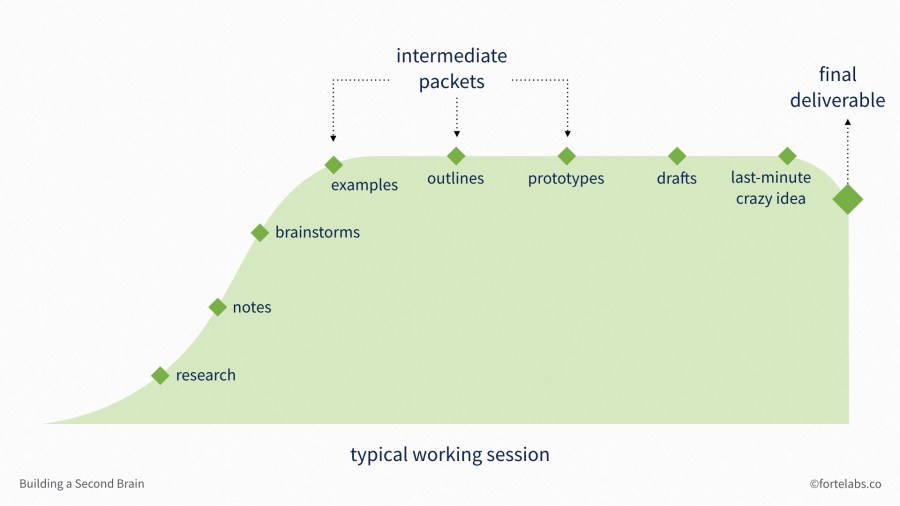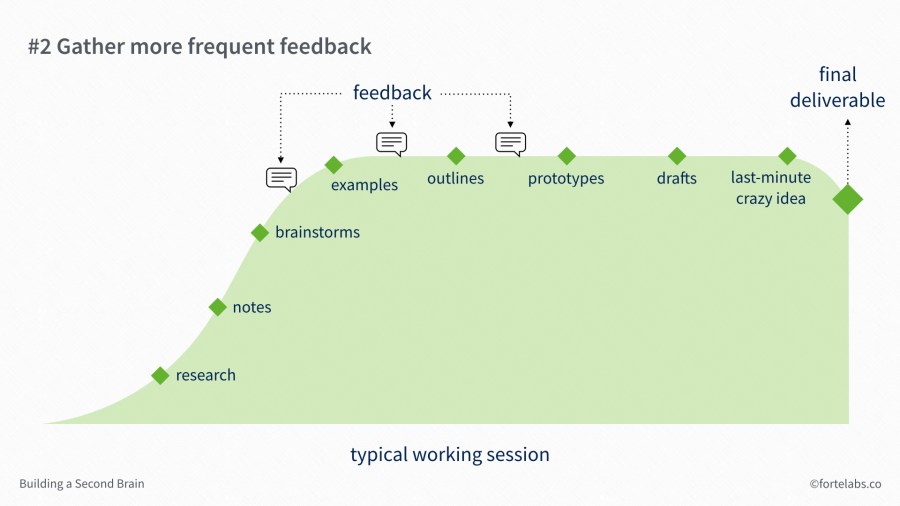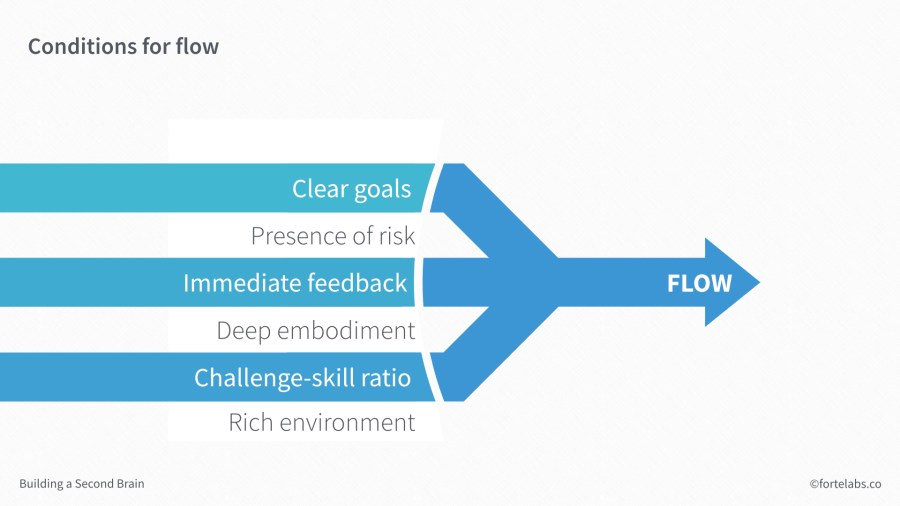
In Part 3, I argued that having a personal knowledge base is the linchpin of success in a creative economy.
A knowledge base allows you to reuse past work, draw from past experiences, share your knowledge in concrete form, and eventually, build products and services out of that knowledge.
This requires strategically structuring your work in the first place, as a series of what I call intermediate packets.
Instead of delivering one big lump of value at the very end, you stage your progress in a series of short, intense sprints, ending each one with a tangible, intermediate deliverable, like a set of notes, a brainstorm, a series of examples, an outline, a prototype, or a draft.
The first benefit of working this way is that you become interruption-proof.
Because you rarely even attempt to load the entire project into your mind all at once, there’s not much to “unload” if someone interrupts you. It’s much easier to pick up where you left off, because you’re not trying to juggle all the work-in-process in your head.
Second, you have more frequent opportunities to get feedback.
Instead of spending weeks hammering away in isolation, only to discover that you made some mistaken assumptions, you can get feedback at each intermediate stage. You become more adaptable and more accountable, because you are performing your work in public.
You will find that others give much better feedback when they are included early and the work is clearly in draft stage. If it’s too highly polished, they’ll either be afraid to critique it, or get hung up on tiny details.
Third, you can create value in any span of time.
If we see our work as creating these intermediate packets, we can find ways to create value in any span of time, no matter how short. Productivity becomes a game of matching each available block of time (or state of mind, or mood, or energy level) with a corresponding packet that is perfectly suited to it.
By always having a range of packets ready to work on, each one pre-prepared to work on at any time, you can be productive under any circumstances – waiting in the airport before a flight, the doctor’s waiting room, 15 minutes in between meetings.
Fourth, big projects become less intimidating.
Big, ambitious projects feel risky, because all the time you spend on it will feel like a waste if you don’t succeed.
But if your only goal is to create an intermediate packet and show it to someone — good notes on a book, a Pinterest board of design inspirations, just one module of code — then you can trick yourself into getting started. And even if that particular Big Project doesn’t pan out, you’ll still have the value of the packets at your disposal!
Finally, you gain the ability to reuse previously built packets for new projects.
Maybe some research you did for an online marketing campaign becomes useful for a new campaign. Or some sketches that didn’t quite make it into an old design give you inspiration for a new one. Or some book notes you wrote down casually turn out to be very useful for an unforeseen challenge a year later.
By incorporating existing packets into new projects, you gain the ability to deliver new projects much faster than seems possible. Eventually, you are able to deliver entire projects just by snapping together existing packets, like Lego pieces. No heavy lifts required.
What’s at stake here is much more than efficiency. Returning to the requirements for flow from Part II, working in intermediate packets has a positive impact on all six triggers:
1. Clear goals
It’s much easier to define your goal for a short-term, intermediate packet, than for a long-term project. Shorter term goals are less likely to change, keeping you motivated.
2. Immediate feedback
As I discussed, it’s much easier to get feedback from others on a quick and dirty experiment than on a highly polished final product. Your efforts feel more connected to the impact you’re having on others, which also makes them more meaningful.
3. Challenge-skill ratio
This refers to the balance between how challenging a task is, and your skill at performing it. If it’s too hard, you’ll give up. But if it’s too easy, you’ll get bored. It’s much easier to calibrate the challenge of a project versus your skills if it’s smaller and shorter (make a 1-page brief) than if it’s a massive undertaking (launch a mobile app).
4. Presence of risk
As you begin to structure your work as intermediate deliverables, you begin to change the type of risk you’re exposed to. Because you know you can “freeze” any deliverable in mid-flight at any time, you no longer fear being interrupted, running out of time, or forgetting the details of what you’re working on. You substitute the risk of not delivering on something large, with the creative risks of going deeper on something small.
5. Deep embodiment
As you offload more and more of your abstract thinking to external tools, new bandwidth begins to open up. This leaves room for noticing your surroundings, the words and actions of others, new sensory experiences, and internal states and bodily sensations. Outsourcing your memory to software frees you up to be present in the moment.
6. Rich environment
The brain is the ultimate pattern recognizer: it can recognize vastly more than it can recall, so it makes sense to collect interesting patterns to help trigger memories, associations, and new ideas. Starting every project by diving into a rich media library full of pictures, drawings, diagrams, videos, sketches, and mindmaps takes advantage of what the brain engages with most naturally – visuals.
Breaking our work into smaller chunks directly creates the conditions for flow. Smaller packets dramatically impact not just the quantity and speed of work we can produce, and not just its quality, but the actual experience of producing it. Work becomes more motivating, more meaningful, easier, more impactful, and more engaging.
Imagine if you could create real value in any span of time, under any conditions, with any level of energy or motivation. Because your productivity is not dependent on your state of mind at any given moment. It depends instead on all the knowledge and expertise you’ve acquired throughout your life, documented in a personal knowledge base.
This is what it looks like to create compounding gains by investing in Knowledge Capital.
Follow us for updates on Twitter, Facebook, Instagram, LinkedIn, or YouTube.
The Only Subscription
You Need to
Stay at the
Edge of AI
The essential toolkit for those shaping the future
"This might be the best value you
can get from an AI subscription."
- Jay S.
Join 100,000+ leaders, builders, and innovators

Email address
Already have an account? Sign in
What is included in a subscription?
Daily insights from AI pioneers + early access to powerful AI tools














Comments
Don't have an account? Sign up!